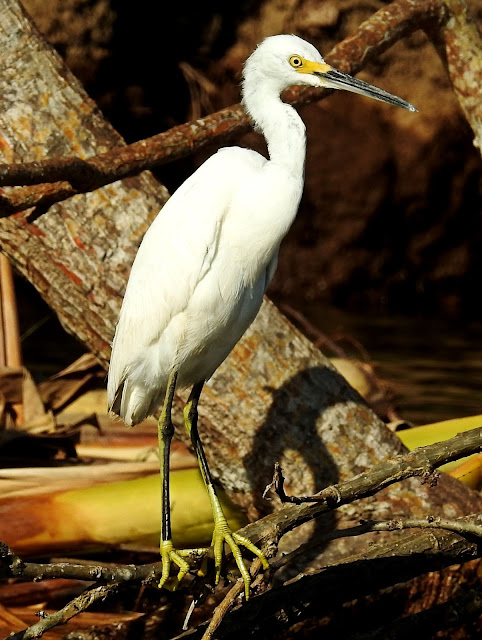The Yellow-crowned Night Heron (Nyctanassa violacea) is a stocky wading bird, with a robust build and a notable large head in proportion to its body. It possesses a hefty bill, set deep under its eyes, and exhibits a wingspan of 101 to 112 cm. The species displays sexual dimorphism, with females slightly smaller than males.
Adults are characterized by a smooth grey-blue body with a black scaled pattern on the wings. Their long legs, which turn coral, pink, or red during courtship, are initially yellow. The head is strikingly black and glossy, with white cheeks and a pale yellow crown that extends from the bill, between the eyes, to the back of the head. This distinctive feature gives the bird its common name. In flight, the Yellow-crowned Night Heron can be distinguished by its long, slow wing beats and legs that extend straight below the tail.
This heron favors shallow waters such as marshes, wooded swamps, and lakeshores for inland populations, and thickets, mangroves, and cliff-bound coasts for coastal populations. It is also found in periodically flooded areas and tolerates a range of water types from fresh to brackish and saline.
The Yellow-crowned Night Heron is endemic to the Americas, with a distribution that closely follows the availability of crustaceans. Its range extends from the southeastern United States to Peru and Brazil in coastal regions.
This species is known for its nocturnal feeding habits, particularly during the breeding season when it feeds its young. It is territorial when foraging but will tolerate others at a safe distance. The heron selects prey visually, employing various hunting strategies, including stalking and standing still before lunging with its bill.
The heron's vocal repertoire includes a loud, sharp squawk used as an alarm or aggression call, a soft chu-chu-chu by begging chicks, and a range of calls during courtship, such as the yup-yup greeting and a concluding whoop from the male.
Breeding is synchronized with the emergence of crabs in spring, varying geographically. The heron forms mating pairs, with some arriving at breeding grounds already paired. Nesting occurs in trees, bushes, or on rock ledges, with both parents involved in nest-building and care of the young.
Juvenile Yellow-crowned Night Herons can be confused with juvenile Black-crowned Night Herons. However, the former tend to stand straighter, have heavier bills, longer legs, and finer spots and streaks on their plumage.
The diet is predominantly crustaceans, with crabs and crayfish being the mainstay. It also consumes insects, fish, worms, amphibians, molluscs, lizards, snakes, small rodents, and birds. The heron's bill size and shape are adapted to the specific prey available in its region.
The Yellow-crowned Night Heron is classified as Least Concern by the IUCN, indicating a stable population trend. However, it faces threats such as habitat loss, human disturbance, and in some regions, illegal hunting. Conservation efforts are generally part of broader wetland conservation projects.



%2020.jpg)









%2020.jpg)
%2021.jpg)
%2022.jpg)
%2020.jpg)
%2021.jpg)



%20(Quiscalus%20major)%2018.jpg)
%20(Quiscalus%20major)%2019.jpg)
%20(Quiscalus%20major)%2020.jpg)
%2020.jpg)
%2021.jpg)
%2020.jpg)
%2021.jpg)
%2022.jpg)





%2020.jpg)
%2021.jpg)
%2019.jpg)
%2020.jpg)
%2022.jpg)
%2020.jpg)
%2021.jpg)
%2022.jpg)
%2023.jpg)


%2010.jpg)